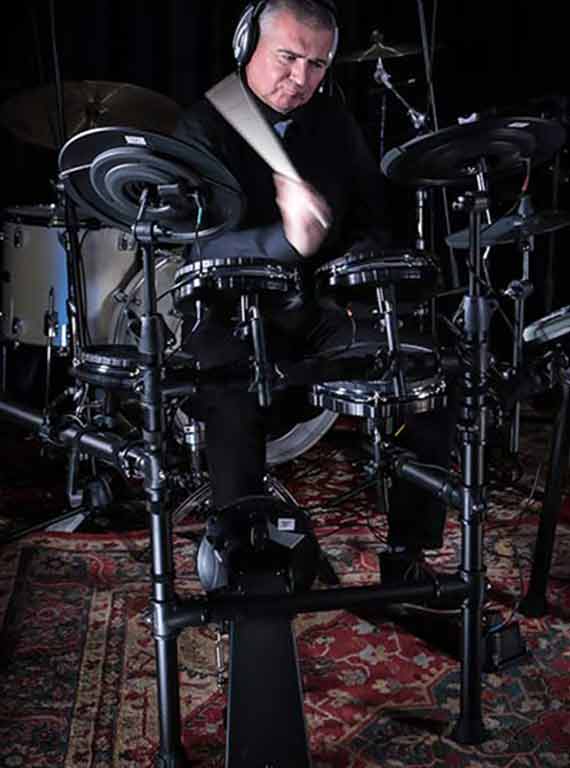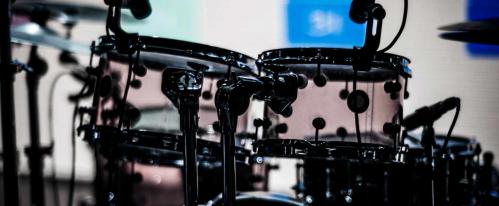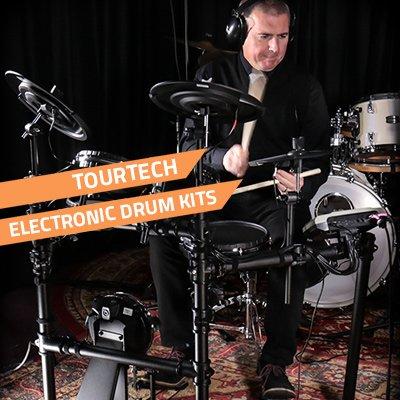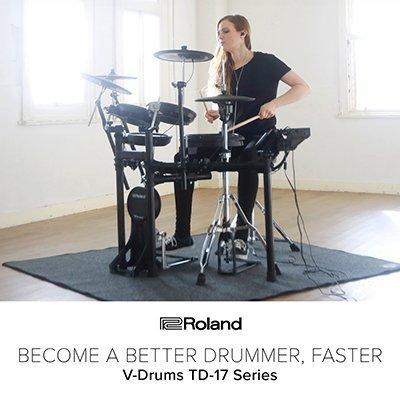A complete electronic drums buying guide for those making their first foray into the world of electronic drum kits
In this blog we'll take a look into the history of electronic drums and answer some key questions you need to consider when buying an electric drum kit.
Why you should choose an electronic drum kit over an acoustic? Which drum kit is right for me? How do electronic drums work? What are drum monitor systems and what are the different pads in electronic drum kits for?
Whether you are a complete beginner or a well established professional there are many variables to consider when purchasing a set of drums. Our ranges of drum sets cater to every different type of drummer and to every different skill level.
If you're still on the fence as to whether to make the plunge into the world of electronic drum kits, we recommend reading our Electronic Drums vs Acoustic Drum guide where we touched on the main differences between the two.
A brief history of electronic drums
When electronic drums first surfaced in the 1980's their playability was nowhere near as good as that of their acoustic predecessors. The rubber pads used to trigger the drum sounds were very hard and playing them for a long period of time could actually cause quite a lot of pain to the user.
The rebound from the pads was also nothing like playing an acoustic drum set, so the skill level of most drummers using electronic kits dropped drastically. This led to electronic drums not being taken seriously in the drumming community.
In recent years though, electronic drum manufacturers such as Alesis, Roland and Yamaha have strived to mimic the feel of acoustic drums, and with great success.
The rubber style pads used on electronic kits feel 100% better than when we first encountered them in the 80's and with the development of the new “mesh style” heads most drummers say that they can't find any difference between the feel of an acoustic drum head and the feel of electronic drums using mesh heads.
Why choose an electronic drum kit?
The main reason for most drummers to choose electric over acoustic is the noise factor. On an acoustic kit there are sound deadening options such as silencer pads and the use of brushes, but both of these do affect the sound of the kit and the rebound off the drum head.
With today's electronic kits you can play pretty much silently by simply plugging your headphones into the sound module so the only noise created is that of the sticks hitting the pads. This way you get the full sound of the kit you are using without compromising on the rebound or feel of the drums.
When using an acoustic kit you are limited to what sound you can get out of it. There are options with tuning the drums slightly differently but in essence, the kit you have bought is always going to sound like that kit. Electronic drums use a sound module to create a multitude of different drum sounds.
Often referred to as the brain of the kit the sound module will come with lots of pre-programmed drum kits in it so while one minute you can be playing a heavy rock kit, at the touch of a button you can switch it to a jazz kit or even an electro voice kit. Some sound modules allow you to mix and match each different drum sound thus creating “user kits”.
Other sound modules go further still in their diversity of sounds. For example, the sound module that comes with the 2box drum it 5 actually allows you to upload your own sounds into the module which gives the user endless options for creativity.
Acoustic kits take up a lot of space and unpacking and repacking them each time you use them is not very realistic. An equivalent electronic kit takes up much less space and most can be folded away with relative ease.
How do electronic drums work?
Each drum or cymbal pad on an electronic kit is linked to the brain by something called a trigger. These triggers are simply sensors that are activated when the surface they touch are struck by the drumstick.
Pads and mesh heads used on electronic drums now can be single or dual trigger. Single trigger means the pad makes one noise no matter where or how hard you strike it. Dual trigger means that the sound produced by the head will be different depending on where you hit it or how hard you hit it.
The rims of the drum heads are also usually active so when you strike them they will create a rim shot effect just like that on an acoustic kit. As soon as the trigger detects a strike it sends a message to the brain which in turn creates the respective drum sound and sends it to the monitoring system.
This might sound like there should be a lag time between the user striking the pad and the sound being created through the monitor but in reality with today's modern triggering methods it is near impossible for the human ear to detect any kind of lag time.
Which electronic drum kit is right for me?
TOURTECH TT-22M Electronic Drum Kit
If you are a beginner, then you might want to start off with one of our basic kits. TOURTECH have a fantastic array of kits ranging from basic budget kits to professional studio kits. The TOURTECH TT-22M Electronic Drum Kit with Mesh Heads, for example, is very quick to set up and has a host of great sounding modern drum kits built in as well as fantastic cymbal and percussion sounds.

Roland TD-17KV Electronic Drum Kit
One of the biggest players in the electronic drum market is Roland who also has a large array of kits on offer that cover everything from the absolute beginner to the high end professional. The Roland TD-17KV Electronic Drum Kit is a compact professional level kit that sounds fantastic but is within reach making it one of the best options for professionals out there today.
The sound module is loaded with hundreds of expressive and diverse sounds at the touch of a button. Its fully tuneable mesh pads not only feel just like the real thing but are a lot more hardwearing than acoustic drum heads.

Yamaha DTX 582 Electronic Drum Kit
The Yamaha DTX582k Electronic Drum Kit is a real beast - packing a rich variety of voices for the professional player. Each kit has extremely high sound quality with "Accent Articulation" for dynamic instruments that change sound characteristics according to your hit velocity.

Drum Monitor Systems
For an electronic drum kit to produce a sound the brain needs to be connected to some kind of amplifier. Amplifiers or monitor systems are specifically designed to create the tones needed for the instrument they are made for. In the same way you wouldn't hook a guitar up to a bass amp and vice versa, an electronic drum kit needs a system designed for its specific range of tones. Most electronic drum manufacturers will also make monitor systems sometimes designed for a specific kit or range of kits. But the most important factor is that the system is designed to amplify drums. Drum monitors are often wedge shaped so they can sit on the floor but face up towards the drummer. The reason for this is so the drummer can have the drum monitor close with the sound being projected directly to them so it can be heard in live and practice situations with a full band.
Click here to view electronic drum monitor systems & accessories
Looking for some information on Acoustic Drums? Want to know what the differences between acoustic and electric are? What's the best beginner kit to buy and why? Keep your eyes peeled...we'll soon have our acoustic drum guide up for you.
View a full range of electronic drum kits over at PMT Online today.







